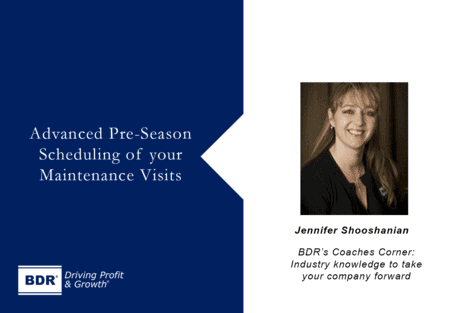Coaches Corner: Advanced Pre-Season Scheduling of Your Maintenance Visits

Advanced Pre-Season Scheduling of Your Maintenance Visits
Greater profits and higher client satisfaction will be realized during maintenance season if you make a strategic plan for scheduling your maintenance visits. Our maintenance clients are the future of our company growth, we must take excellent care of them. Sadly, without a strategic plan, our maintenance clients often suffer. Mother nature gives us a gift that drives our demand service up, and the re-scheduling begins of our very best clients, our future replacement opportunities.
Let’s review key scheduling techniques:
Perform the bulk of your agreements during non-peak seasons. Be cautious with your language and communication as to when the service will be performed. Focus on language that speaks to the heating visit / cooling visit verses spring/fall or every six months. As your agreement base grows, you will be doing maintenance year-round. Customers believe they need to have their systems serviced before it gets hot or before it gets cold because we have trained them that way.
Early in the season focus on the following:
- Homes with multiple systems and those in the outlying service areas
- Single system agreements and those in our main service area are easier to manage in the schedule as the season progresses.
- Set up your agreements by service area’s / zones.
- This will optimize your routing and improve your travel time efficiencies.
- The travel time should be 15 minutes or less between calls.
- This will optimize your routing and improve your travel time efficiencies.
- Optimize your scheduling strategy by working a full season in advance.
- Dentist offices have been using this method for several years.
There are many benefits of advanced pre-season scheduling:
- BDR clients have reported as much 65% of their clients participating with less than 2% rescheduling.
- When demand season begins to roll in, customers won’t have the perception of “not getting their maintenance done on time” since we have them scheduled.
- Routing is optimized.
- Fewer challenges reaching clients to complete your maintenance commitments.
- You can redirect your calling to non-agreement customers to drive growth in your agreement base.
- Retention rates are improved.
Implementation Steps:
- Create a maintenance capacity calendar.
- Define your capacity for scheduling based on the number of visits and/or labor hours. This will be different for every company based on seasonal trends and number of technicians.
- For Example:
- Assume your call capacity is 5 calls per day per technician and you have 5 Service Technicians. Your call capacity is 25 calls per day.
- Maintenance capacity calendar example:
- March-Schedule to 80% capacity or 20 calls per day.
- April-Schedule to 70% capacity or 17 calls per day.
- May-Schedule to 60% capacity or 15 calls per day the first ½ of the month, moving to 50% capacity or 12 calls per day the second ½ of the month.
- Dispatcher pre-schedules the next season’s visit when contact is made with the client for scheduling the current owed visit.
- Inform the technician of the next visit date when dispatched.
- Technician notes on the invoice the date of the next visit.
- Set up a reminder schedule:
- 1 month prior to visit.
- 1-week prior 2nd notification
- 1-day prior 3rd notification.
- Of course, always call when in route.
There are several options for setting up a reminder schedule, you will need to determine what is best based on the systems you have available. Phone calls, postcards, emails and texts are all options that should be considered.
Speak to your coach about getting a detailed procedure in place. We have a template to get you started that includes a flow chart, scripts, and additional details. You can also attend Service Dispatch University or the Residential Maintenance Class, and we will train your service team for you.
The best time to start is this Fall for Spring of 2020. Don’t delay, begin working on your strategy now. It will improve your efficiency and client experience.
Jennifer Shooshanian
Service Coach

